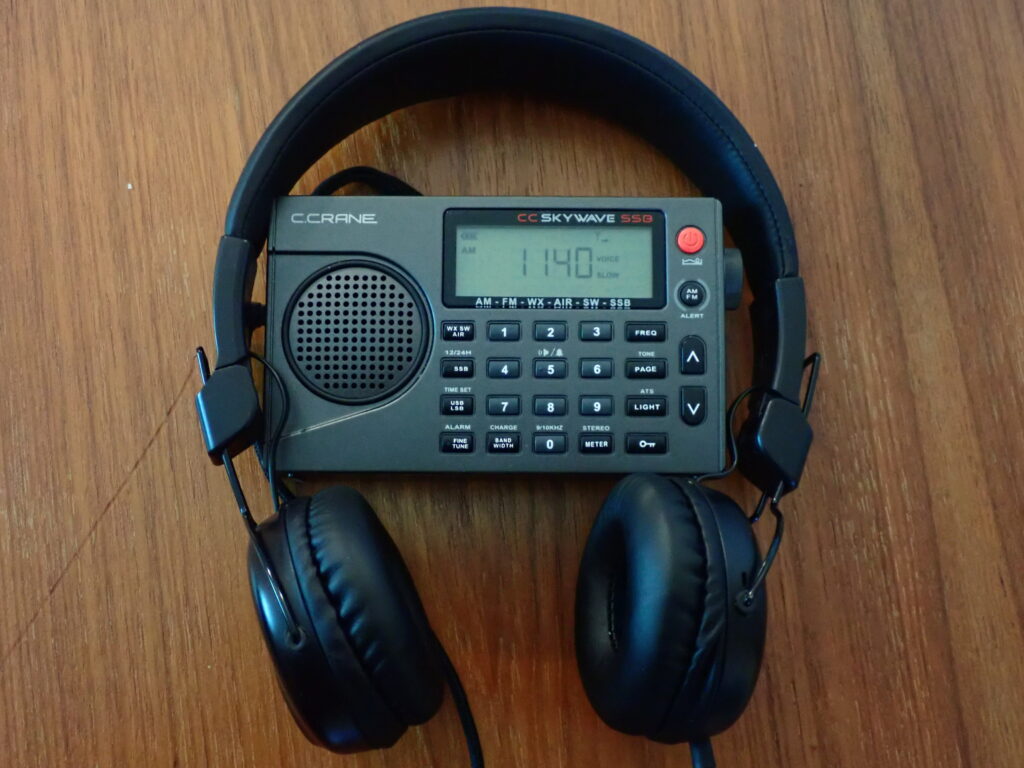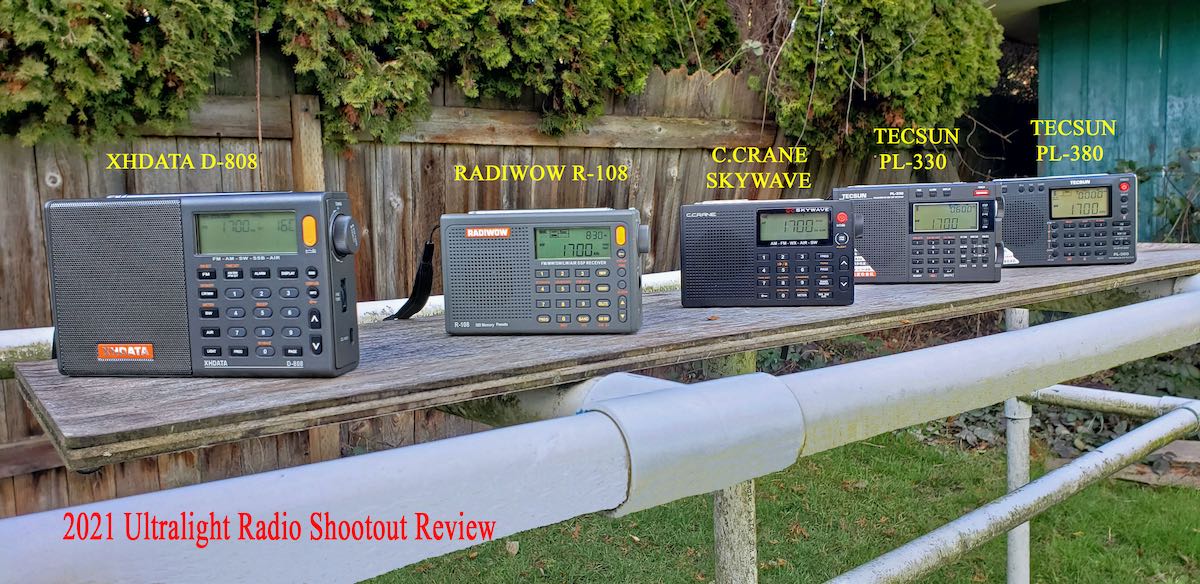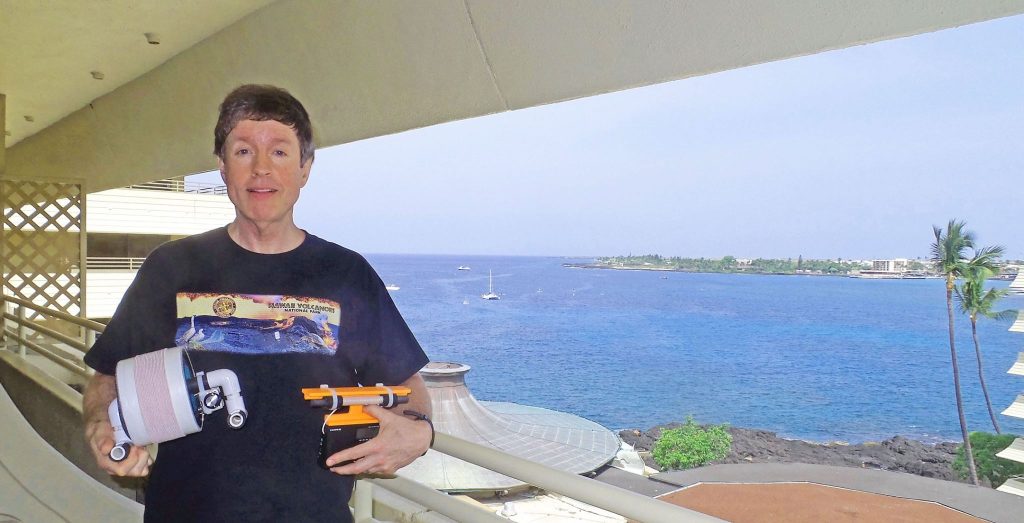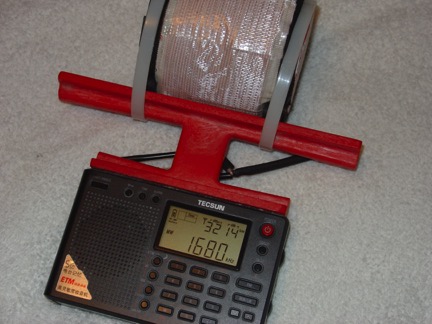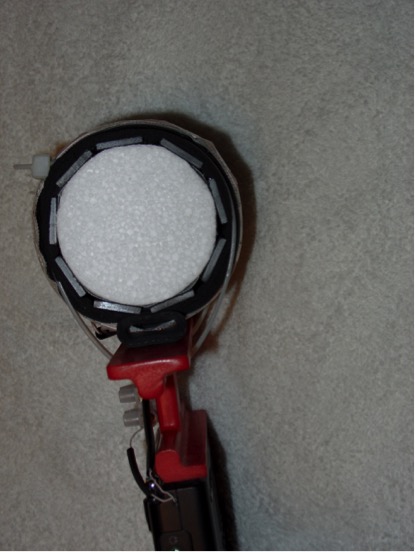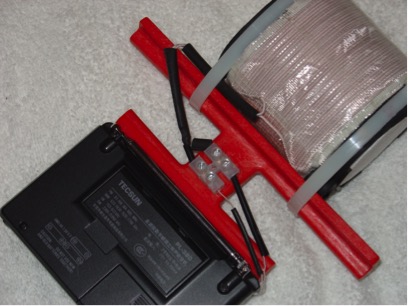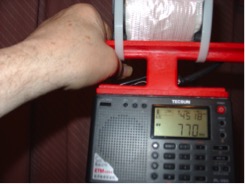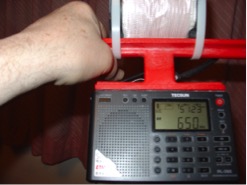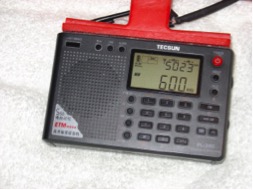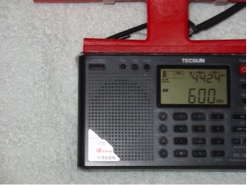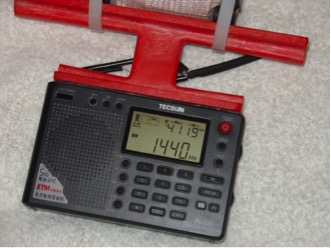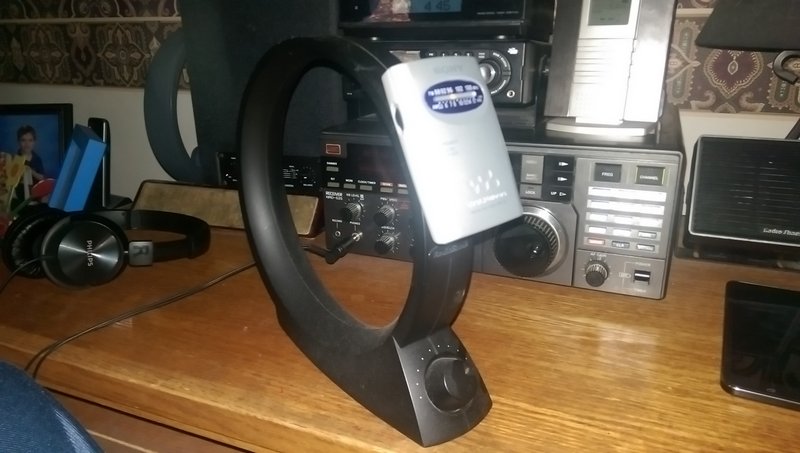
Many thanks to SWLing Post contributor, Carlos Latuff, who shares the following recording of some ultralight DX catches while he travels in Ireland:
Tag Archives: Ultralight DXing
A little barefoot ultralight MW DXing . . . in which my mental status is questioned
By Jock Elliott, KB2GOM
About 10 days ago, the Better Half and I visited my wife’s sister in Sodus, NY, a small town in the western part of the state near the shores of Lake Ontario.
First consideration when packing was – never mind the underwear and the toothpaste – what radios shall I take? I decided to go light . . . just a CCrane Skywave SSB and a Uniden BC125AT analog-only scanner.
In the predawn hours on a handful of mornings, I decided to see what I could hear on medium wave with the diminutive Skywave SSB. The Skywave is an “ultralight” radio – under 20 cubic inches in volume. Because the Skywave’s plastic case is so small, the ferrite antenna within it is very small . . . less than 3 inches long. It is by no means a huge antenna for grabbing signals.
It was Gary DeBock who pioneered ultralight DXing with tiny generally inexpensive radios. As a ham radio operator, he had worked 144 countries using a Heathkit 1-2 watt kit transmitter he had built. In the process, he learned a great deal about propagation.
In 2007, he decided to see what he could do with a cheap pocket radio, a Sony Walkman SRS 59. At 1 am on an autumn night from his home in Washington state, he put propagation and operating skill to work and heard three distant medium-wave stations: a couple from Japan and one from Korea. He posted his results on the internet in November, 2007, and he got a lot skeptical feedback: How could you possibly do this?
His response (in essence): Try it for yourself.
Some people did try for themselves; some with great success. One DXer from Canada logged 300 stations in 30 days. Interest in MW DXing with pocket-sized consumer radios took off, and ultralight DXing was born.
So, in the predawn hours in Sodus, NY, I decided to give ultralight DXing a try . . . barefoot . . . that means with no external antennas or signal boosters . . . just me kicked back in a recliner, the CCrane Skywave SSB, and a pair of headphones. Simple.
Before we proceed, you need to understand that my DXing style might charitably be described as “lazy.” Instead of laboriously turning the tuning knob, I use the seek function on the CCrane Skywave. I simply press and hold for a moment the up or down arrow and wait for the Skywave to stop at the next signal it detects. Then, if I feel that the signal might be enhanced by re-orienting the antenna with respect to the signal, I wiggle the Skywave around in my hand and listen for an improvement in what I am hearing through the headphones.
The results: I logged (among others) Atlanta, Georgia (493 miles) and Charlotte, North Carolina (588 miles) on the CCrane Skywave SSB with its tiny internal antenna. Also received: Boston, Philadelphia, New York City, Baltimore, and Toronto and a bunch of unknowns.
One afternoon, I decided to see what distant stations Skywave might receive during the daylight hours. I was kicked back in the recliner with headphones on, doing my usual, waving the Skywave around in the air to optimize the reception. My sister-in-law started laughing. She said I looked like a demented band leader, conducting a silent orchestra! I tried to assure her that my mental status was OK and that I was trying to optimize the signal. I’m not sure it worked.
But one thing is certain: barefoot ultralight MW DXing is fun. All you need is a tiny radio, a bit of darkness, a pair of headphones, and a willingness to be surprised.
Gary DeBock’s 2021 Ultralight Radio Shootout!
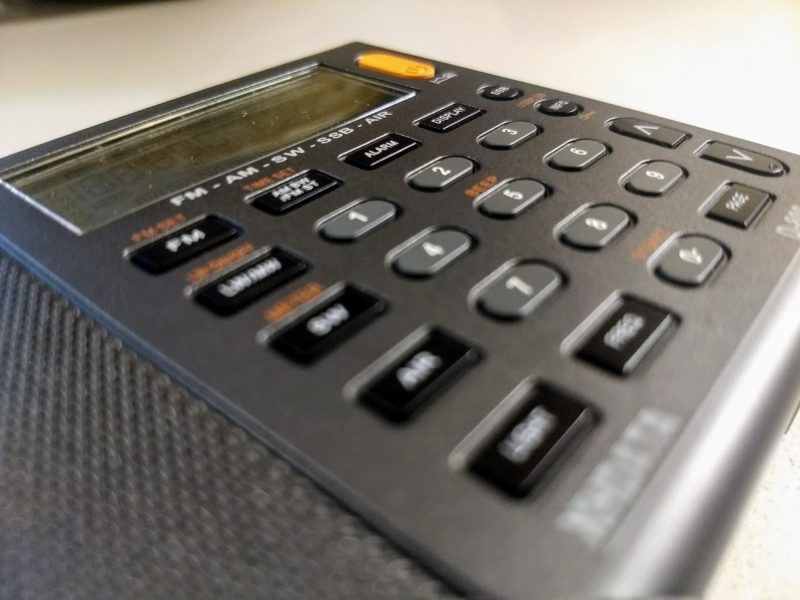 Many thanks to SWLing Post contributor, Gary DeBock, who shares his extensive 2021 Ultralight Radio Shootout.
Many thanks to SWLing Post contributor, Gary DeBock, who shares his extensive 2021 Ultralight Radio Shootout.
This is truly a deep dive featuring five popular ultralight portable radios and examining mediumwave, shortwave, FM, and AIR Band performance.
The review is an amazing 40 pages long! In order to display the entire review, click on the “Continue reading” link below.
2021 Ultralight Radio Shootout
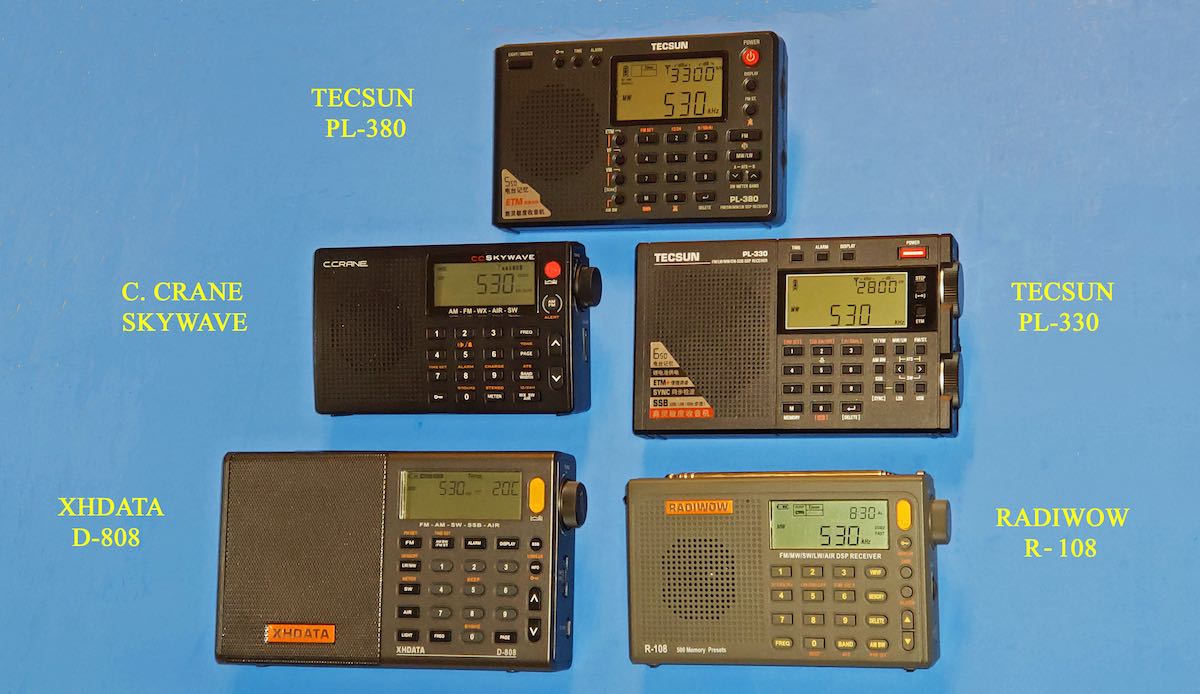
Five Hot Little Portables Brighten Up the Pandemic
By Gary DeBock, Puyallup, WA, USA April 2021
Introduction The challenges and thrills of DXing with pocket radios have not only survived but thrived since the Ultralight Radio Boom in early 2008, resulting in a worldwide spread of the hobby niche group. Based upon the essential concepts of DXing skill, propagation knowledge and perseverance, the human factor is critical for success in pocket radio DXing, unlike with computer-controlled listening. The hobbyist either sinks or swims according to his own personal choices of DXing times, frequencies and recording decisions during limited propagation openings—all with the added challenge of depending on very basic equipment. DXing success or failure has never been more personal… but on the rare occasions when legendary DX is tracked down despite all of the multiple challenges, the thrill of success is truly exceptional—and based entirely upon one’s own DXing skill.
Ultralight Radio DXing has inspired spinoff fascination not only with portable antennas like the new Ferrite Sleeve Loops (FSL’s) but also with overseas travel DXing, enhanced transoceanic propagation at challenging sites like ocean side cliffs and Alaskan snowfields, as well as at isolated islands far out into the ocean. The extreme portability of advanced pocket radios and FSL antennas has truly allowed hobbyists to “go where no DXer has gone before,” experiencing breakthrough radio propagation, astonishing antenna performance and unforgettable hobby thrills. Among the radio hobby groups of 2021 it is continuing to be one of the most innovative and vibrant segments of the entire community.
The portable radio manufacturing industry has changed pretty dramatically over the past few years as much of the advanced technology used by foreign companies in their radio factories in China has been “appropriated” (to use a generous term) by new Chinese competitors. Without getting into the political ramifications of such behavior the obvious fact in the 2021 portable radio market is that all of the top competitors in this Shootout come from factories in China, and four of the five have Chinese name brands. For those who feel uneasy about this rampant copying of foreign technology the American-designed C. Crane Skywave is still available, although even it is still manufactured in Shenzhen, China—the nerve center of such copying.
Prior to purchasing any of these portables a DXer should assess his own hobby goals, especially whether transoceanic DXing will be part of the mission– in which case a full range of DSP filtering options is essential. Two of the China-brand models use only rechargeable 3.7v lithium type batteries with limited run time, which may not be a good choice for DXers who need long endurance out in the field. A hobbyist should also decide whether a strong manufacturer’s warranty is important. Quality control in some Chinese factories has been lacking, and some of the China-brand radio sellers offer only exchanges—after you pay to ship the defective model back to China. Purchasers should not assume that Western concepts of reliability and refunds apply in China, because in many cases they do not. When purchasing these radios a DXer should try to purchase through a reputable seller offering a meaningful warranty—preferably in their own home country.
One of the unique advantages of Ultralight Radio DXing is the opportunity to sample the latest in innovative technology at a very reasonable cost—and the five pocket radio models chosen for this review include some second-generation DSP chip models with astonishing capabilities. Whether your interest is in domestic or split-frequency AM-DXing, FM, Longwave or Shortwave, the pocket radio manufacturers have designed a breakthrough model for you—and you can try out any (or all) of them at a cost far less than that of a single table receiver. So get ready for some exciting introductions… and an even more exciting four band DXing competition!
Gary DeBock’s Ultralight Radio DXpedition in Hawaii
Many thanks to SWLing Post contributor, Gary DeBock, who shares the following notes and recordings from an Ultralight DXpedition in Kona, Hawaii:
The Kona, Hawaii Ultralight Radio DXpedition was conducted from a sixth floor oceanfront motel room in the Royal Kona Resort Motel from April 9-12 (during an anniversary trip with my wife). A newly designed “airport friendly” 5 inch FSL antenna (designed to fit within hand-carry luggage, inside a plastic tote) and a 7.5 inch loopstick C.Crane Skywave Ultralight were used to track down and record Asian and South Pacific Medium Wave DX from such rare stations as 540-2AP (Apia, Samoa), 621-Tuvalu (Funafuti, Tuvalu) and 1440-Kiribati (Bairiki, Kiribati). Here are three extremely strong recording links for these exotic stations, including the daily sign off routines for 621-Tuvalu and 1440-Kiribati:
540 2AP Apia, Samoa Extremely strong Christian worship music (Samoan style) at 0931 UTC on April 9 (S9+ level)
621 Tuvalu Funafuti, Tuvalu Over 8 minutes of traditional island music at an S9 level, including the sign off routine (with national anthem) at 1000 UTC
1440 Kiribati Bairiki, Kiribati Over 7 minutes of traditional island music, station ID’s in English and the native language, and the national anthem (followed by a blistering 1000 Hz tone) at the 0936 UTC sign off– all at a strong level
Guest Post: July 2016 Rockwork 4 Ocean Cliff DXpedition
Many thanks to SWLing Post contributor, Gary DeBock, who shares this summary of the July 2016 Rockwork 4 Ocean Cliff DXpedition:
July 2016 Rockwork 4 Ocean Cliff DXpedition
An International Team Gets Full “Exposure” to a Wild New DXing Venue
By Gary DeBock, Puyallup, WA, USA
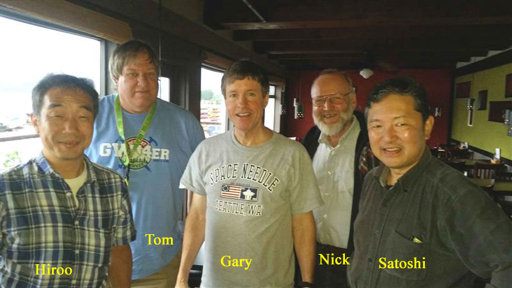
Introduction
In the previous century the outstanding receivers developed by the Japanese Sony and Panasonic companies introduced many of us to the thrill of shortwave listening as teenagers, and created an unusually dedicated DXer hobby group in Japan, as well. The Japanese MW-DXing group has all along been extremely active in the hobby, although the challenge of English communication has somewhat limited their interaction with other DXing groups.
Recently I was highly honored to introduce several modified Ultralight radios to the Japanese DXers, who not only tried these out with great interest, but who also designed and set up modification procedures for Japanese-made equivalents. One of the leaders in this effort was Satoshi Miyauchi, who has already built not only his own 7.5” loopstick Tecsun PL-380 model, but has also built his own 3 inch and 4.25 inch FSL Tecsun PL-380 models as well. When Satoshi-san inquired about the possibility of participating in one of our Rockwork 4 ocean cliff DXpeditions this summer (along with his friend, the famous Japanese MW-DXer Hiroo Nakagawa), I was thrilled to issue the invitation.
The Rockwork 4 turnoff site on Highway 101 is a sweeping ocean view site about 419 feet (158 meters) directly above the Pacific near Manzanita, Oregon. This would be the first time that any international visitors would participate in an ocean cliff DXpedition. Our North American TP-DXing group has always had a great interest in Japanese DX and Japanese DXers, and this would be the first major North American DXpedition to feature MW-DXers from both countries. Canadian Nick Hall-Patch (of Victoria, B.C.) also was highly interested in participating with the Japanese, and as such, our 5-man DXpedition group was composed primarily of DXers from other countries (with only Tom Rothlisberger joining me as repeat American participants).
Although my own DXpedition efforts started on the morning of July 5th, Nick and Tom both joined up for the session on Saturday, July 9th. We all welcomed our Japanese guests (with a joint dinner at the aptly named “Tsunami” restaurant in Wheeler, Oregon) that evening, and prepared for what we hoped would be a very memorable DXing session early the next morning.
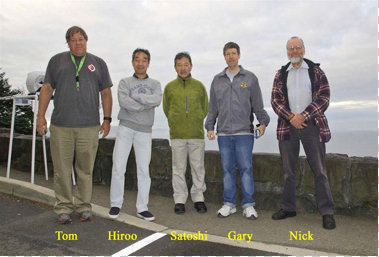 Well, it certainly was very memorable—in the worst possible way. A toxic mix of gale force winds and pounding rain was hammering the ocean cliff site as soon as we arrived for antenna setup at 1015 UTC (0315 local time), which was far and away the worst weather that any of us had ever experienced in an outdoor DXpedition. The sensible Japanese had at least brought suitable rain gear for the session, which was more than the careless North Americans had brought. Tom and I ended up thoroughly drenched and shivering as soon as the antennas were set up, while Nick was partially drenched. A single 15 inch FSL antenna was set up on its PVC base and strapped tightly down to the ocean cliff wall with heavy-duty plastic tie wraps, enabling Satoshi, Hiroo and I to track down some New Zealand, Australian and Tahiti DX with our Ultralight radios despite the vicious weather. Tom’s broadband loop supports absolutely refused to stay upright in the gale force winds, and he eventually had no option other than going outside in the nasty weather to hold one of them in the vertical position manually as he recorded DX on his Perseus-SDR. Nick’s active vertical whip was relatively impervious to the vicious weather, but he was drenched from the knees down because of the pounding rain during its early morning setup.
Well, it certainly was very memorable—in the worst possible way. A toxic mix of gale force winds and pounding rain was hammering the ocean cliff site as soon as we arrived for antenna setup at 1015 UTC (0315 local time), which was far and away the worst weather that any of us had ever experienced in an outdoor DXpedition. The sensible Japanese had at least brought suitable rain gear for the session, which was more than the careless North Americans had brought. Tom and I ended up thoroughly drenched and shivering as soon as the antennas were set up, while Nick was partially drenched. A single 15 inch FSL antenna was set up on its PVC base and strapped tightly down to the ocean cliff wall with heavy-duty plastic tie wraps, enabling Satoshi, Hiroo and I to track down some New Zealand, Australian and Tahiti DX with our Ultralight radios despite the vicious weather. Tom’s broadband loop supports absolutely refused to stay upright in the gale force winds, and he eventually had no option other than going outside in the nasty weather to hold one of them in the vertical position manually as he recorded DX on his Perseus-SDR. Nick’s active vertical whip was relatively impervious to the vicious weather, but he was drenched from the knees down because of the pounding rain during its early morning setup.
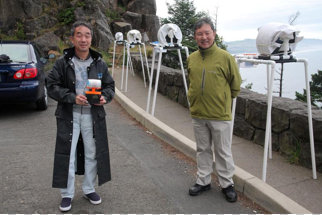
That entire July 10th session was thoroughly miserable for all of us, but both Satoshi and Hiroo showed great optimism and determination throughout the three hour struggle, which made all of us highly motivated to do the same!
Fortunately, DX (and weather) on the next (and final) morning would allow our Japanese and Canadian guests to experience the South Pacific DX propagation that this cliff is famous for providing. Satoshi and Hiroo became quick experts in New Zealand “big gun” stations, and Satoshi had a great thrill when 738-Tahiti pounded in at an S9 level on his homemade 3 inch FSL Tecsun PL-380 portable.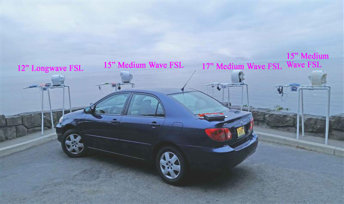
Propagation definitely favored New Zealand throughout the week (in one of the most Kiwi-slanted trips that has ever been observed here). Although we had a near-daily blowtorch signal from 738-Tahiti and occasional reception from 1017-Tonga, Australian signals generally had a rough time in the NZ-slanted conditions. Tom and I both agree that overall propagation was down somewhat from the exceptional conditions we enjoyed last summer (when we enjoyed good reception of stations like 558-6WA and 558-Fiji) but the chance to welcome the Japanese DXers made the experience especially memorable, and their skill and determination was an inspiration to us all. Listed below are the DU loggings made with my Ultralight radio + FSL antenna combos, which performed quite well throughout the vicious weather challenges on July 10th (better than the drenched and shivering DXer that created them, actually). The DU loggings made by the other DXers will no doubt exceed these, but we all had great fun together, and are looking forward to the next joint DXpedition (either here, or in Japan).
531 4KZ (Innisfail, Australia, 10 kW) MIA during Kiwi-slanted propagation on most mornings, it made it through at a modest level with its classic oldies format and interval signal during PI fade at 1209 on 7-5
https://app.box.com/s/phtsbdii0tatmxeb0qfq677it0emsa3i
531 More FM (Alexandra, NZ, 2 kW) Rare low-powered Kiwi station played hard to get, but did show up during a deep PI fade in Kiwi-slanted propagation at 1222 on 7-6. This Kiwi English monolog sounds mostly garbled to me, but the first 5 seconds certainly sounds like “Welcome time to More FM’s blog…” (headphones recommended)
https://app.box.com/s/q527grcf5ee5q2l402sjiwl3syn8d8g4
531 PI (Auckland, NZ, 5 kW) Samoan broadcaster dominated on all 7 days with good signals, although 4KZ and More FM did manage to get through at times. This good-level Samoan female speech on 7-5 was typical
https://app.box.com/s/pe8gr1917b4vn3gccskee5gep6go7cft
567 RNZ (Wellington, NZ, 50 kW) Most of this big gun’s legendary transoceanic signal seems to have been destroyed along with its old tower (during the recent demolition). It showed up weakly on all 7 days, although always inferior in strength to its 675 parallel
https://app.box.com/s/2mqql3qwk3vxg0ym5iu4tpi5f8ppvvj7
576 2RN (Sydney, Australia, 50 kW) Kiwi-slanted propagation hit this RN-network big gun pretty hard, but it did show up with mediocre signals not // 657 at 1237 on 7-8
https://app.box.com/s/g39m6brj1dgh6qwx5i7m8xz45ynqu9yy
576 Star (Hamilton, NZ, 2.5 kW) The “Dwarf Star” (ex-The Word) was strong enough with its Christian female vocal music to confirm the parallel with 657 at 1244 on 7-11. The first 12 seconds in the recording are 576-Star, and the last 12 seconds are the 657 parallel
https://app.box.com/s/m548dxdvwu1ke99z4e1y2r12prfdf809
585 Radio Ngati Porou (Ruatoria, NZ, 2 kW) Wispy male speech was received at 1234 on 7-6 sounding like the usual Maori announcer, but the 603 // apparently started a new song right during the parallel check. Signal nosedived thereafter.
594 Rhema (Timaru/ Wanganui, NZ, 5/ 2 kW) Modest level Christian music // 684 at 1250 on 7-6. Usually a little stronger than the 684 parallel, with no sign of Aussie big gun 3WV during the Kiwi-slanted conditions
https://app.box.com/s/m2d7qbws87z5z1jg8d8n4lvqmz298p8k
603 Radio Waatea (Auckland, NZ, 5 kW) Usually the strongest of the Maori network, this vibrant regular plays a mix of Maori and Motown music. Its strongest signal was on the last day (7-11) at 1218
https://app.box.com/s/xdxju7jr1flspiln9nz1havsvd8gy85o
657 Star (Wellington/ Tauranga, NZ, 50/ 10 kW) Christian hymn broadcaster owned the frequency during the Kiwi-slanted conditions, with this good-level music at 1211 on the last day of 7-11
https://app.box.com/s/mxti60qwfcc3298c541ak4k5p9s3vqj5
675 RNZ National (Christchurch, NZ, 10 kW) The new kingpin of RNZ network transoceanic strength (after the demise of 567’s old tower), this relay consistently outperformed its 50 kW parallel. This signal at 1257 on 7-8 was typical
https://app.box.com/s/wx9b9i1dex7mqyrb9b9zgbnk1n3svwew
684 Rhema (Gisborne, NZ, 5 kW) Christian contemporary music broadcaster with fairly good signals // 594 at 1247 on 7-9; Tony W. says that the tower property has been sold and eviction is forthcoming
https://app.box.com/s/691ddrcehygaiko5pgpll2jp1nu1en91
702 2BL (Sydney, Australia, 50 kW) Easily pushing 702-Magic aside whenever it showed up, this Oz big gun was the dominant station on both 7-7 and 7-10. The interview format was much different from Magic’s oldie music
https://app.box.com/s/f0qfop5x7ymw1gbyowg65obveuqjwf6m
702 Magic (Auckland, NZ, 10 kW) Capable of blistering signals when Kiwi propagation was enhanced, this oldie music broadcaster was the only DU on the frequency on 5 of 7 days
https://app.box.com/s/gtd8u8zxduwpirycbso99kigyum2ja5c
738 Radio Polynesie (Mahina, Tahiti, 20 kW) A real blowtorch on most days, this French-language signal at 1233 on 7-9 was the strongest DU recording made during the trip, and seriously tested the crunch resistance of my Ultralight radio
https://app.box.com/s/pw2gpfgh7vd19b33yz8ag7466y18462t
756 RNZ (Auckland, NZ, 10 kW) Pretty good signal with music // 675 at 1212 on 7-8, a good demonstration of the cliff’s ability to cut down splatter from the 750-Portland pest (50 kW and only 70 miles away)
https://app.box.com/s/qlx6esrtgccrg32pkwqt0yr71suuw52d
765 Radio Kahungunu (Napier-Hastings, NZ, 2.5 kW) Once again this low-powered Maori network station acted very much like a Kiwi big gun throughout the week. Maori and Motown music is the norm, as in this recording // 603 at 1215 on 7-8
https://app.box.com/s/p04c5i3fvvpxfw449nbsa2jlwmipsh6n
774 3LO (Melbourne, Australia, 50 kW) LR Network big gun was strong at 1222 on 7-5 but missing in action under Radio Sport on most days
https://app.box.com/s/egf89xhr29obvisblm7cb9bzehid62jh
774 Radio Sport (New Plymouth, NZ, 5 kW) Not nearly as strong as its 792 parallel, it was hit hard by Seattle splatter on most mornings, and never came up in strength for a decent recording
783 Access Radio (Wellington, NZ, 10 kW) Multi-cultural station with varied ethnic programming, this apparent Samoan language music and speech was received at 1241 on 7-7
https://app.box.com/s/yg4xp9r7er4hyul4jvcpsr5x747vqkf2
792 Radio Sport (Hamilton, NZ, 5 kW) Fairly strong on most mornings with its network relay of Fox Sports News, the Yankee-accented English owned the frequency on all 7 days (over the MIA Oz big gun 4RN)
https://app.box.com/s/um0gfok28blvq90n0eeoeuuoq3v5jzzy
828 3GI (Sale, Australia, 10 kW) On a couple of occasions this LR network big gun was just strong enough to confirm the parallel with 774, but most often it was in a ghostly mix with a presumed Radio Trackside (which never came up in strength for a decent recording).
891 5AN (Adelaide, Australia, 50 kW) Another underperforming Oz big gun, it was usually in a threshold-level mix with another DU English station (probably 4TAB).
936 Chinese Voice (Auckland, NZ, 1 kW) A prime target during enhanced Kiwi propagation, this low-powered ethnic station came through with fairly good-level music and Chinese speech during exceptional propagation at 1243 on 7-6
https://app.box.com/s/sng6i7c70sqm3e5bpymy3mfy1dbpbfdn
1008 Newstalk ZB (Tauranga, NZ, 10 kW) Getting through the 1010 splatter at a modest level // 1035 at 1220 on 7-7. Generally not as strong as either the 1035 or 1044 parallel
https://app.box.com/s/8l5sn7mayuwkzs896lbciw4s1e8738dw
1017 A3Z (Nuku’alofa, Tonga, 10 kW) Rushed antenna setup prior to 1130 on 7-9 paid off with a fairly good-level logging of male speech from this station, the only foreign language DU on the frequency. Since A3Z’s sign off is usually prior to sunrise enhancement at the cliff, the best chance to track it down is during its late Saturday night transmission, when it typically stays on a little later
https://app.box.com/s/jz35gvlr8re5ldfqol9h6ux0kd04dea5
1035 Newstalk ZB (Wellington, NZ, 20 kW) The flagship relay of this talk radio network had potent signals on most mornings, including this excellent-level discussion concerning NZ real estate at 1222 on 7-8
https://app.box.com/s/a21xkbboz6pbbqj73lj0ted4ft3fjiua
1044 Newstalk ZB (Dunedin, NZ, 10 kW) Fairly strong on most mornings with the usual call-in talk program and occasional music // 1035. This recording was at 1210 on 7-9
https://app.box.com/s/z7flaydc0if63v9qhro7deyvp3rno67d
1386 Radio Tarana (Auckland, NZ, 10 kW) Hindu music broadcaster pounded in when Kiwi propagation was enhanced (as in this recording at 1246 on 7-6), otherwise it got lost in splatter
https://app.box.com/s/aaguop8hp57aa38eulommx06tm3l22qw
1503 Radio Sport (Wellington/ Christchurch, NZ, 5/ 2,5 kW) Yankee English from the relay of Fox Sports News (// 792) was usually audible on this frequency on all 7 days
https://app.box.com/s/wed793j34pnu0thkulc3w8o7v716gs98
73 and Good DX,
Gary DeBock (DXing at the Rockwork 4 Ocean Cliff near Manzanita, OR, USA)
7.5″ loopstick C.Crane Skywave Ultralights (3) +
15″ and 17″ FSL antennas
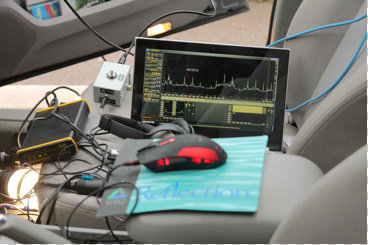
Report from Tom Rothlisberger
Saturday July 09
Three of us on the ocean cliffside pullout this morning. It took some time to set up everything as this was a new antenna and configuration for me at the cliffs, and I was planning to experiment with a vactrol for the first time. A major setback occurred when my Win10 notebook refused to recognize the Perseus hardware due to a possibly corrupt driver. To make matters worse I did not bring the backup MSI Wind U100 that I have been using for years with good results. Note to self: always bring backup. I wound up borrowing Nick’s netbook as he did not need it for experiments that morning. So it was 1222 by the time I started recording. Magic 702 was slamming in and 1KW TAB Trackside on 549 was in nicely but briefly. I didn’t think the session was as good as what was experienced last year but everything was working and signals were loud at times, usually briefly, before settling back down into the noise. Little high band action but 1503 Radio Sport was in.
Sunday July 10
Driving rain and gale force winds were making things miserable. My antenna spreaders blew down time after time. For the last 15 minutes of the opening I was holding one up outside by hand, the other secured to the rock wall by heavy straps.
This turned out to be a morning favoring Australia. 1116 4BC was ruling the band with huge signals, I had Aussies on 702 and 936 instead of NZ stations. The ABC News fanfare was heard on 891 on the half hour and there was audio on 1566, 1611 and 1701. This was the only of the three mornings the whole band was in although not very robust like it was last August. IDing signals is still ongoing.
We were all soaked to the bone when it was over, my Gore-Tex jacket was no match for that storm. Distinguished visiting DXers Hiroo-san and Satoshi-san were still smiling at the end. That’s really the important thing, to have fun and overcome adversity. That we heard any stations at all was an added bonus. And we did hear some! We will always remember this morning.
Monday July 11
Another mostly New Zealand morning, decent signals but they would fade back down after a minute or two, and something else would become strong elsewhere on the band, one at a time. This made getting parallels for ID purposes difficult. On several frequencies NZ and Australia signals were fighting it out. It was another low band morning. The TAB Trackside affiliate on 1224 (1 KW) was briefly good but almost nothing heard above it except for occasional audio from Radio Sport 1503. 738 Tahiti was slamming in with meter-bending signals. Satoshi-san and Hiroo-san seemed very pleased as this station is considered rare and exotic DX from Japan.
Overall: 657 Star gets the award for strongest and longest lasting DU signal over the three days, beating last year’s champions 1035 Newstalk ZB and the no longer potent RNZ 567. I had more wire up this year but the signals were really no better. I failed to find a “sweet spot” with the vactrol for reducing splatter from the Portland powerhouses.
Longwave: DX NDBs were practically non-existent. I am wondering if the antenna configuration made it deaf at LW, or if conditions were really that terrible. Only one DX station, 352 KHz “RG” Nikau, Rarotonga, Cook Islands was noted. 531 PI was also exceedingly weak so I suspect the antenna. I will be changing things again at my next visit to the ocean cliffs to ensure I get more LW action.
73, Tom K7WV
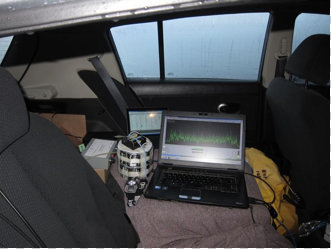
Report From Nick Hall-Patch
As promised, a logging or two, and a couple of photos:
549 NEW ZEALAND, Napier-Hastings, TAB Trackside Radio. Man talking, sounded like announcing a horse race, becoming fair //828 1220 July 9. (NHP)
594 NEW ZEALAND, Timaru/Wanganui, Star. Light music, poor strength, //909 July 10. (NHP)
693 NEW ZEALAND, Dunedin, Radio Sport. Poor to fair strength, American sport talk //792 1225 July 9 (NHP)
729 NEW ZEALAND, Tokorua, R. New Zealand National. Light Dixieland style mx, poor strength, seemed //675 but slightly offset so hard to say for certain. Only there for a minute or two, 1212 July 9. (NHP)
747 JAPAN, Sapporo, JOIB. Briefly poor and //774, with man in what sounded like Japanese, certainly not DU English, 1136 July 10. (NHP)
774 NEW ZEALAND, New Plymouth, Radio Sport. Fair to good signal, earlier //792 with American sport talk, bit of electrical noise, unusual for this quiet location, 1227 July 9. (NHP)
792 NEW ZEALAND, Hamilton, Radio Sport. American sport talk, fair strength in splatter //774 1224 July 9. (NHP)

828 NEW ZEALAND, Palmerston North, TAB Trackside Radio. Horse race announcer, fading up to good strength with a little splatter, 1223 July 9, earlier ID’ed by //549. (NHP)
1611 // 1629 t AUSTRALIA, but who? 1216 July 10.
http://www3.telus.net/public/shallpat/rockworks/1611_1629parallel_20160710_1216.wav
Not what I would call listenable, but somewhat identifiable DX, could be a preacher, which might be Vision Radio Network, but several sites on each channel. Not heard on other days, so a bit out of the ordinary. (NHP)
(NHP) RFSpace NetSDR, RFSpace SDR-14 running DX Fishbarrel program; AMRAD active 4’ whip antenna
Report From Satoshi Miyauchi
(July 28) It is just like last week that we had been there! All those memories are good to remember, including the very precious “welcoming” weather on 10th morning! It just showed that even for short period of stay, at least TWO sessions might be required …
DXing results are of course something that we really appreciate out of the DXpedition, but simply the fact that we could meet up and DXing together means a lot! And also both Hiroo and me were very much impressed by all of your efforts even in the middle of darkness and especially in the stormy weather. As for us also, it was the worst weather we ever had on the day of DXpedition! So in many ways we could get “first ever” in this joint DXpedition! We hope that we all can meet sometime in the future either at the cliff, Cliff in Japan, or any other location in the world! Thanking you once again for your hospitality, and actual support on equipments that we could use throughout the DXpedition!
Best 73,
Satoshi Miyauchi
DXpedition Videos
First Day Tour (July 5th, FSL antenna setup)
http://www.youtube.com/watch?v=MBeoUF0ruvQ
July 9th Antenna Setup (Tom, Nick and Gary)
http://www.youtube.com/watch?v=V8Kn2vrBzK0
The Session from Hell (July 10th)
http://www.youtube.com/watch?v=Lw9k6E08eME
Final Day Success (July 11th)
http://www.youtube.com/watch?v=cjda-kO_oQE
Wow! Gary, thanks so much and thanks to all of the team members–Hiroo, Satoshi, Tom and Nick–for sharing your experiences. Though your weather was less than desirable, it appears your DX was quite successful. You’ve so many mediumwave loggings from New Zealand, I’m convinced you were actually in New Zealand! Most impressive!
Most importantly, it sounds like you all enjoyed a little DX fellowship. At the end of the day, that’s what it’s all about. We look forward to future DXpedition reports!
Guest Post: Jerry’s Mediumwave DXing Powerhouse Mini FSL Antenna
Many thanks to SWLing Post contributor, Jerry Popiel, for the following guest post:
A MW DXing Powerhouse Mini FSL Antenna
by Jerry Popiel
In late February 2016 I completed construction of a modified version of Gary DeBock’s excellent 3 inch Mini FSL design (click here to view).
This new antenna is nothing short of a AM DXing powerhouse with unbelievable sensitivity for receiving stations across the entire AM Bandwidth both day and night. The tuning of stations is razor sharp and it has stunning nulling qualities. Consultation assistance was provided from DXing experts Steve Ratzlaff and Gary DeBock on the project.
Construction Details:
The Antenna was constructed using 9 – 100 mm Ferrite Bars wound on a 2.75 inch diameter x 4 inch styrofoam cake dummy form custom made by in Vancouver, B.C. Canada – ([email protected]) for $3.50 plus shipping.
The Coil wire consisted of 38 turns of high gain 660/46 Litz Wire. (Note: As can be seen 38 turns of the thicker Litz Wire left only 5/8” of room on each side of the Styrofoam Form to wire wrap the coil to the ruler frame. A longer Form ie 5” long would work much better for this build).
The insulation spacer used was 2 layers of 1/8 inch Aerotape self adhesive tape which also helped hold the 100 mm Ferrite Bars onto the Styrofoam Coil Form. Inductance measured 356 uH using a DM 4070 Meter which is well within the requirement of over 300 uH for AM Band Reception.
Because of the extra thickness of high gain 660/46 Litz Wire which is a bit too big to solder to the inside terminals of the Tecsun PL-380 Radio, a 2 Position Terminal Block was superglued to the outside of the Ruler Frame to act as an interface connection point.
Testing Results:
Both daytime and evening AM station captures have been spectacular. Stations as far away as KKOB / 770 kHz Alberquerque, New Mexico 1130 Miles from here in Winnipeg, Manitoba, Canada have been received. Country music station WSM / 650 kHz in Nashville, Tennessee 1082 miles distant is a daily evening pickup.
Two Stations Received At 600 kHz 90 Degrees apart at the same time:
The amazing Nulling and Razor Sharp Tuning quality of this FSL was demonstrated when 2 stations at 600 kHz were received at the same time by rotating the Radio with attached FSL 90 degrees. In the North / South direction Station KSJB / Jamestown, North Dakota (219 miles distant) was received with a strong signal strength of 50 / 23. Then by rotating the Radio 90 degrees to the East / West direction Saskatoon, Saskatchewan station CJWW (442 miles distance) was captured with a similar strong signal strength of 44 / 24.
Daytime Reception of 600 Watt Station 137 Miles Distant:
A major daily AM reception capture during the afternoon illustrating the amazing sensitivity of this antenna is 600 Watt station KKXL Sports Radio 1440 kHz (137 miles).
All Indoor Reception – For Now!
Due to winter conditions here in Winnipeg, all of the amazing station reception captures in this report were done inside the House facing towards the South window. Fortunately the red ruler platform sides can he used as handles when pointing the radio in the direction of best reception. Exciting times are ahead to see how well this mini 3” FSL will perform outdoors for likely even better AM DXing.
Summarizing:
The design of this new FSL Antenna attached to the Tecsun PL-380 Ultralite radio by Gary DeBock is a major breakthrough in AM DXing since the Radio is attached to the FSL. This new FSL Antenna needs to be constructed to be really appreciated. The application described here requires a bit more skill to construct and is also heavier than the original construction – but at least it is portable. For beginners Gary’s original 3” FSL Heathkit Design is highly recommended and can be reviewed in his You Tube Video posted at: https://www.youtube.com/watch?v=VY9u8MReGjk
Thanks,
Jerry Popiel
Winnipeg, Manitoba, Canada
Thank you, Jerry! It’s amazing what performance you and Gary DeBock have gotten out of these homebrew FSL antennas! Thank you so much for taking the time to share your construction details and performance notes!
Bill’s simple Sony SRF-59 passive loop antenna modification
In reference to our previous posts about the Sony SRF-59 ultralight receiver, SWLing Post reader, Bill Mead, writes:
“As someone who doesn’t normally open the backs of radios, this is my mod on my ultralight. All it takes is a bit of electrical tape to hold the belt clip on the loop.”
That is, indeed, a brilliant and simple mod. The SRF-59 inductively couples to the loop antenna, so no soldering is needed; simply tape the belt clip to the loop, making sure the position is convenient for tuning the SRF-59 and the loop’s capacitor.
You can find passive loop antennas ranging from $19 to $50 US. The Grundig AN-200 and the Terk AM Advantage are two models currently on the market. Here are a few places you can check prices:
Grundig AN-200:
- Universal Radio ($19.99 at time of posting!)
- Amazon.com (who also sells the same antenna branded as the Kaito AN-200)
- eBay.com
Terk AM Advantage:

